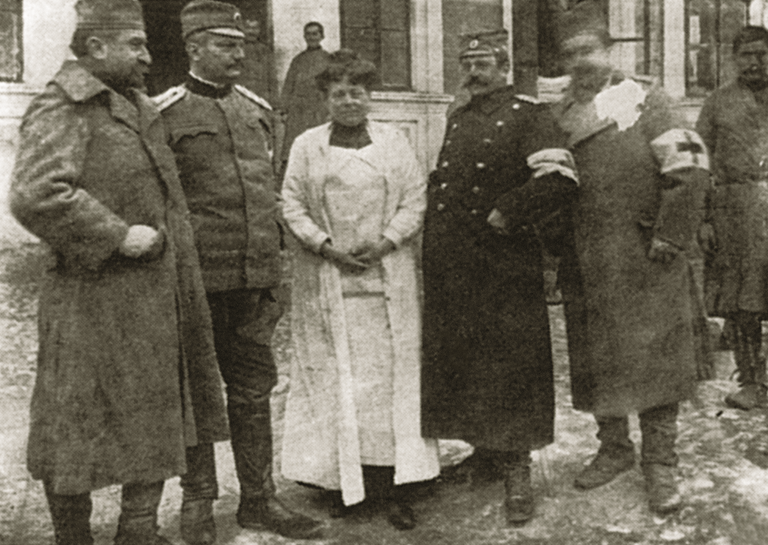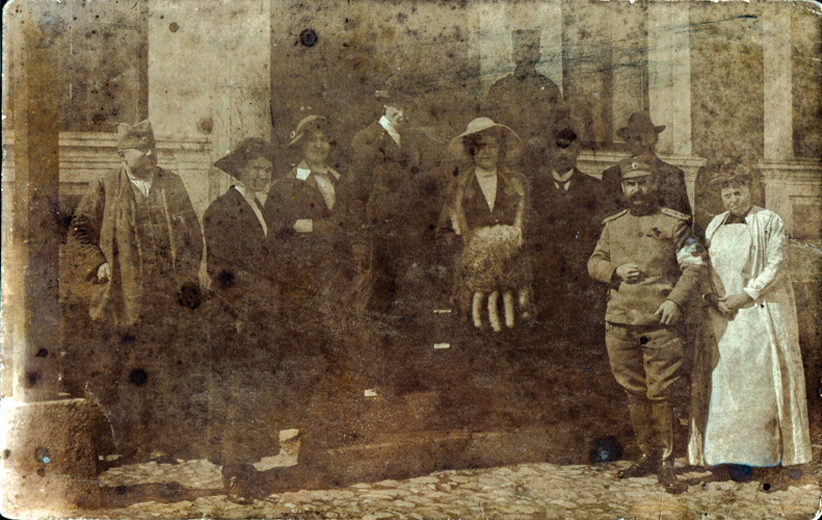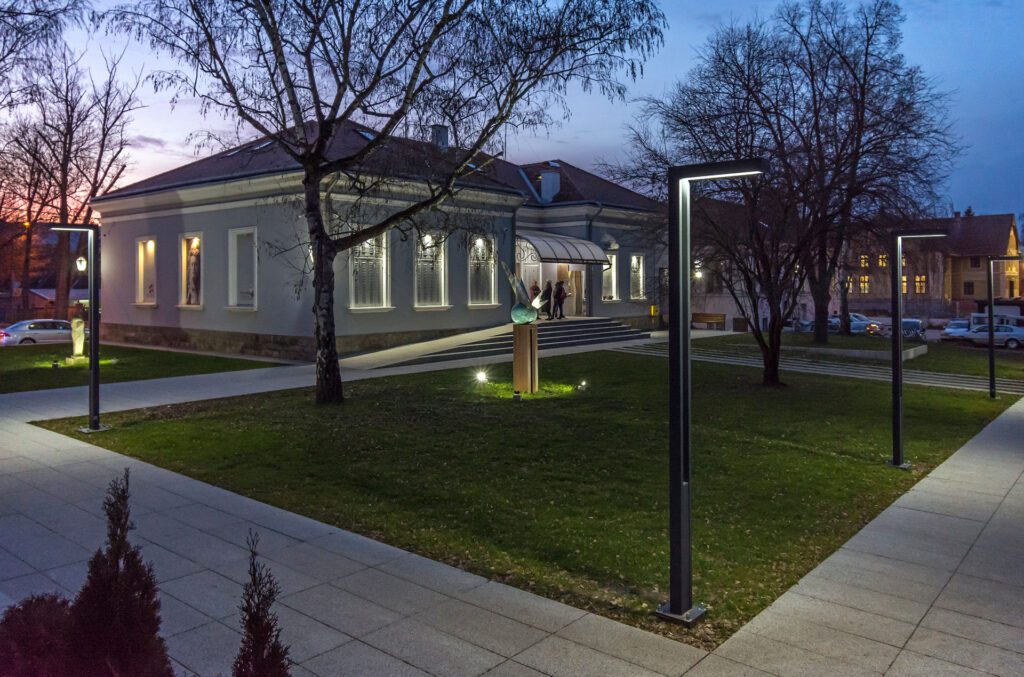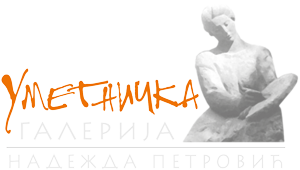
Nadežda Petrović was born on October 11, 1873 in Čačak, as the first female child out of thirteen children of Dimitrije Mita Petrović from Belgrade and Mileva Petrović, née Zorić, from Titel. Dimitrije and Mileva Petrović were teachers in Čačak - Mita a teacher of freehand drawing in the Gymnasium, and Mileva a teacher of the Women's Basic School. When she was seven years old, due to Mita's health, the family moved to Karanovac (Kraljevo), where Nadežda started elementary school.
The family's return to Belgrade in 1884 was due to several reasons: the abolition of the subject of freehand drawing in elementary schools, which left Mita without a job, the death of Mita's father, Hadži Maksim, and the continuation of Nadežda's education. The move was a turning point for the Petrović family in every sense. They lived in the old family house in Ratarska street in Palilula. Mita got a job at the Tax Administration, where he advanced very quickly. He tried to provide necessities for the family and educate the children, while Mileva left the teaching profession because of the children and running the house.

Nadezhda enrolled at the prestigious Women's Higher School, which at that time provided modern forms of education and solid professional knowledge in all areas of pedagogical education. She was preparing to become a teacher and at the same time attended private drawing lessons with her father's friend, the famous realist painter Đorđe Krstić. She inherited her painting talent from both her father's and mother's side. With her father, who received her painting education from the famous artist Steve Todorović, she learned to draw in elementary school, and from her uncle, engineer Svetozar Zorić, professor at the University, a lover of painting, to use colors. She fell in love with poetry, about which, as well as history, she received lessons from her mother. She especially loved the songs of Vojislav Ilić and Njegoš, learned them by heart and recited them to her younger sisters and brother Vladimir. Due to her innate seriousness, diligence, loyalty and consideration for every member of the family, she was considered an extremely characterful person, a real authority and had a great reputation both in her family and in the wider family.
Visits to Đorđe Krstić's studio were the most exciting and beautiful thing for her. She listened to Krstić's instructions and lectures with great attention and tried to fully master painting skills. Already in his studio, he starts to make oil paintings. After that, as the first student of the female class, she attended the painting studio of Slovak artist Kirill Kutlik.
After graduating from the Higher Women's School in 1891 and her first independent painting works, she felt ready to embark on new paths in life. Her clear stance on the issue of commitment to fine arts guided her towards that goal - to become a drawing teacher and to continue further artistic training. Having passed the qualification exam, Nadežda gained the status of a teacher of freehand drawing in secondary schools and in early September 1893 was appointed as a drawing teacher at the Women's High School, and then at the Women's Teacher's School and the Women's Gymnasium in Belgrade.
Neither Krstić nor Kutlik left much of a mark on her later works, but the fact is that it was Đorđe Krstić who encouraged Nadežda to go to art studies in Munich.
The influence of the Slovenian art pedagogue Anton Azbe, in whose studio in Munich she continued her training since 1898, and the artistic climate she found there, forever changed Nadezhda's understanding of painting art, but also the entire Serbian art. She met many young artists in the studio. Later, she works in the studios of Julius Ekster and Angelo Janke, who further profile her painting path, above all, her openness to German expressionism. She intended to stay in Munich for one year, and she stayed for four years. She tirelessly painted Bavarian landscapes, visited exhibitions and learned German, Russian and French.
The impression is that going to Munich, in addition to professional development, also contributes to seeing your life from a distance. Insulted by the actions of her fiance's mother, who demanded a large dowry from her parents, Nadezhda broke off the engagement in 1898 and, seeking support for this gesture from Munich, wrote to her mother: "I want to be a painter, not a woman, there are plenty of women." If you really want me to be happy, then you too will only expect me to be a painter, not a matchmaker."
In 1900, Nadežda entered the public painting scene in Serbia, which was met with "storm and uproar", with an exhibition at the Great School. Negative reviews did not discourage her, because she knew her own path, which could not be the path of classical painting schools. She understood the non-acceptance and even the public condemnation of her painting as a misunderstanding of an environment accustomed to traditionalism and tried not to let criticism interfere with her daily work.
After studying in Munich, Nadezhda returned to Serbia at the end of 1902. The paintings created in Munich are like, for Serbian painting, a completely unexpected portrait Bavarian with a hat, present a different artistic path compared to the prevailing academic-realist attitudes. She continues to paint in the manner of an energetic expressionist and at the same time works as a drawing teacher at the Women's High School. She wrote texts about exhibitions, events in culture, politics and fashion of that time, trying to contribute to the progress of the country and society as a whole.
In 1903, by participating in the founding of the organization "Circle of Serbian Sisters" and bringing humanitarian aid to the regions not liberated from Turkey, Nadežda began her social engagement. Deeply devoted to her family, she was one of the first to become a member of the National Defense, a patriotic society whose goal was to help Serbs who were still under Turkish rule. After Macedonia and the horrors she saw there, cold and sick, she retreated to the family estate in Resnik for a while and devoted herself entirely to painting and preparing works for the upcoming big "South-Slovenian" exhibition. The following year, in 1904, he embarked on a major task of organizing the First Yugoslav Art Exhibition and founding the Society of Serbian Artists "Lada". Along with the publication of art criticism, with reviews of the painting of his contemporaries, noting the need to overcome decadent thinking and traditionalist art concepts, he simultaneously works on the establishment of the First Yugoslav Art Colony in Sićevo near Pirot, which began its work in 1905, emphasizing the influence of German and French trends in our painting and the need to work outside the studio. For her involvement with the great Yugoslav exhibition, she was awarded the Order of St. Sava IV degree.
Nadezhda participates in the founding of the Serbian Art Association, and on the occasion of the annexation of Bosnia and Herzegovina in 1908, she gives fiery speeches from the balcony of the National Theater. The house in Ratarska street becomes the gathering center of Serbian patriots. Along with these activities, he tirelessly paints and participates in numerous exhibitions. It is the most fruitful period of her creativity (the so-called Serbian phase), with anthological works of Serbian art created directly in nature, on trips around Serbia, in Sićevo, Resnik - Belgrade Cemetery, Resnik, Self-Portrait, Woman with a Red Scarf, Kaluđer, Dereglije on Sava, Harvest…
Pressured by rather large financial difficulties, present since her father's sudden retirement (1903), after several rejected applications she finally managed to get a scholarship from the Ministry and in 1910 she went on a study stay in Paris. He is staying in the studio of Ivan Meštrović, his friend from the Munich days. Lots of paintings, visits museums, salons and artists' studios, participates in social events - attends the reception during the arrival of King Peter I the Liberator at the "Pacific Journalists' Society" banquet, talks about the state of the Serbian people in the southern regions under Turkish rule. She ended her stay in France in April 1911, as soon as she heard about her father's death. After her return to Serbia, a difficult period of life begins for her, although she is still extremely active. She continued to work at the school and advocate for the construction of an art pavilion in Belgrade, and she organizes a summer painting school in her home. During all that time, he took care of his seriously ill mother, who died in August 1912.
Од почетка Првог балканског рата (1912), па до своје смрти, Надежда је на бранику отаџбине. Неизмерно родољубље показује на тај начин што се пријављује као добровољна болничарка и са српском војском проживљава тешке тренутке на простору Косова и Метохије. Ни драматични призори у санитету у позадини фронта, а још мање болест (прележала је тифус, колеру и упалу плућа), нису је омели да покаже неизмерну љубав према свом роду и својој земљи. Након кратког одсуства, које је провела у Скопљу ради опоравка од тифуса прележаног за време епидемије у пролеће 1913, поново се придружила српским војницима. Кратки предах између два балканска рата провела је у Београду.
During the month of the Second Balkan War, in the summer of 1913, as a volunteer nurse, she was engaged in the area of Macedonia in the War Zone Health Service, at the Supreme Command for Military Service. After the end of the Balkan wars, she was awarded for bravery and the Red Cross for mercy for her dedication and zeal in service.

After the war, he went on a short visit to Venice with his sister Anja. In Belgrade, he continues his activities in the Committee for the Organization of Artistic Affairs of Serbia and Yugoslavia, the goals of which are, among other things, the establishment of a large art school, the creation of an art industry of national character, the establishment of a Gallery of copies and plaster models, the establishment of the Yugoslav Modern Gallery in Belgrade, the improvement of theatrical decorative art, construction of Meštrović's Vidovdan temple, establishment of the Art Department in the Ministry of Education, as well as a number of other program goals.
In January 1914, Nadezhda experienced a great tragedy - the death of her beloved sister Andja. She was unable to work for a long time, so only in March, together with Isidora Sekulić, she gave lectures at the school on the artistic education of the youth.
The declaration of war in 1914 found her in Italy, where she visited the exhibition of the Venice Biennale with her youngest brother Rastko, where she wanted to see the sculptures of her great friend Ivan Meštrović. She immediately returned to the country to once again show her loyalty to her homeland in action. Rejecting the proposal of the Supreme Command to join the Red Cross Commission in Switzerland, she went to work at the field hospital of the Danube Division. With the army, she arrived from Srem to the vicinity of Krupnje, where great battles were fought and where, surviving the worst horrors, she bandaged many wounded soldiers and officers from the most serious murder wounds. For the celebration of her baptism (Saint Archdeacon Stefan on January 9), she traveled to Skopje, where her family was in exile. And although, by order of the Military Command, she is scheduled to represent Serbia at the conference in Rome or to go to the hospital of the foreign mission in Niš, in February she returns to the Military Medical Center in Valjevo. She remained on duty as a nurse for the rest of her life, tending to the wounded, painting ruins, officers, the tent of the Polish military hospital and taking care of typhoid patients. After contracting typhus again, after a seven-day agony, she died on April 3, 1915, in the Military Hospital in Valjevo.
The remains of Nadežda Petrović were transferred from Valjevo to the family grave at the New Cemetery in Belgrade on June 2, 1935.
The dedicated work of Nadežda Petrović in Polish hospitals on the battlefields, her courage and her own sacrifice as a volunteer nurse, remained as a special, bright memory, as important as the warrior merits of soldiers and officers at the front, which are often, with the absence of any pathos that Nadezhda herself despised, apostrophizes as an example of the highest loyalty to her own country and people.


Nadežda Petrović Čačak Art Gallery
Cara Dušana 6, Čačak
Phone +381 32 322 375